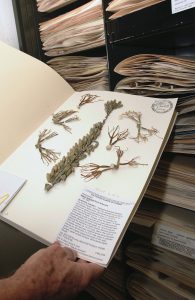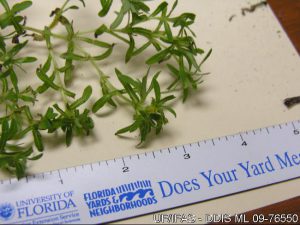How to take a good photo of a plant
UF/IFAS Extension Botanist Marc Frank shares his tips for taking good-quality images to identify plants:
Plant identification is often not merely a matter of recognition, but a process of diagnosis based on observation of a suite of morphological features (whether the plant is woody or herbaceous; characteristics of the flowers and fruit; the shapes, margins, venation, and textures of the leaves; the way the leaves are arranged; whether there are hairs or spines present; etc.). Plant classification and plant identification are based primarily on aspects of flowers and fruit, so it may not be possible to identify photos of a sterile (non-flowering/non-fruiting) plant. Photographs need to show enough features to make diagnosis possible. A casual photo of a plant taken at a distance might be alright for an ID based on recognition, but it is rarely sufficient for the purposes of diagnosis. To give the diagnostician the best chance in confidently identifying your plant, try the following:
- Send multiple photos of any plant to be identified—including photos of th
 e whole plant, as well as close-ups of the leaves, flowers, and fruit. A single photo often is not sufficient for ID. Photos from different perspectives (side views as well as top views) may reveal essential clues leading to an identification. For example, in the aster family the phyllaries (bracts subtending the flower head) can be quite diagnostic, but in photos taken from above, the phyllaries are not visible. Also, including a scale (ruler, coin, etc.) in the close-up photos is very helpful.
e whole plant, as well as close-ups of the leaves, flowers, and fruit. A single photo often is not sufficient for ID. Photos from different perspectives (side views as well as top views) may reveal essential clues leading to an identification. For example, in the aster family the phyllaries (bracts subtending the flower head) can be quite diagnostic, but in photos taken from above, the phyllaries are not visible. Also, including a scale (ruler, coin, etc.) in the close-up photos is very helpful. - Photos should be high resolution (in the size range of 500KB to 5 MB, the higher the better!). Lower resolution images are extremely challenging to work with because when the diagnostician tries to zoom in to look for specific features, the image just becomes pixelated or blurry. When sending photos taken with a smart phone, select the option to send as large a photo as possible. Digital cameras also have a setting to increase photo resolution.
- Photos should be sent as JPEG attachments to an email, not embedded in the body of an email or saved as a PowerPoint slide, PDF, or Word document. When photos are pasted into the body of an email, slide, or document, the photo file size is minimized. The diagnostician is then unable to zoom in to look for the features needed to make a confident ID.
- In addition to providing photos, it is essential to provide descriptive information, such as: the county where the plant is growing, the county where the client resides (if different from where the plant is growing), whether the plant is cultivated or not, and the context (residential yard, nursery, potted plant, forest, pasture, orchard, beach dune, etc.). A brief description of the plant (whether it is woody or herbaceous, approximate size, whether leaves or flowers are fragrant, etc.) can be very helpful.
- If the plant that the client wants identified is growing amongst many other plants (for example, as a weed in a lawn or in a dense forest understory or a thicket of weeds), then it is better to cut or pull up a sample of the plant and photograph it against a neutral surface such as a sidewalk, a tabletop, or a piece of paper. Otherwise, the diagnostician will not be sure which plant to identify!
When is a photo just not enough?
 For the purposes of an accurate plant identification, UF/IFAS Extension Botanist Marc Frank shares that a physical sample is ALWAYS preferable to a photo. For certain groups of plants in particular (grasses, sedges, and rushes), ID is based on microscopic aspects and measurements of the spikelet (flowering unit) and it is just not possible to provide confident species ID based on photos. Additionally, with seedlings and other sterile (non-flowering, non-fruiting) plants, photos may not be sufficient, depending on photo quality and how distinctive the plant is. Good quality physical samples are often added to the UF Herbarium collection, where they serve as teaching and research tools for centuries! To learn more about submitting a physical plant sample for identification, review the guidance available from the Plant Identification and Information Service of the UF Herbarium.
For the purposes of an accurate plant identification, UF/IFAS Extension Botanist Marc Frank shares that a physical sample is ALWAYS preferable to a photo. For certain groups of plants in particular (grasses, sedges, and rushes), ID is based on microscopic aspects and measurements of the spikelet (flowering unit) and it is just not possible to provide confident species ID based on photos. Additionally, with seedlings and other sterile (non-flowering, non-fruiting) plants, photos may not be sufficient, depending on photo quality and how distinctive the plant is. Good quality physical samples are often added to the UF Herbarium collection, where they serve as teaching and research tools for centuries! To learn more about submitting a physical plant sample for identification, review the guidance available from the Plant Identification and Information Service of the UF Herbarium.
Thanks to Marc Frank, UF/IFAS Extension Botanist, for his contributions to this article.
 0
0
 e whole plant, as well as close-ups of the leaves, flowers, and fruit. A single photo often is not sufficient for ID. Photos from different perspectives (side views as well as top views) may reveal essential clues leading to an identification. For example, in the aster family the phyllaries (bracts subtending the flower head) can be quite diagnostic, but in photos taken from above, the phyllaries are not visible. Also, including a scale (ruler, coin, etc.) in the close-up photos is very helpful.
e whole plant, as well as close-ups of the leaves, flowers, and fruit. A single photo often is not sufficient for ID. Photos from different perspectives (side views as well as top views) may reveal essential clues leading to an identification. For example, in the aster family the phyllaries (bracts subtending the flower head) can be quite diagnostic, but in photos taken from above, the phyllaries are not visible. Also, including a scale (ruler, coin, etc.) in the close-up photos is very helpful.